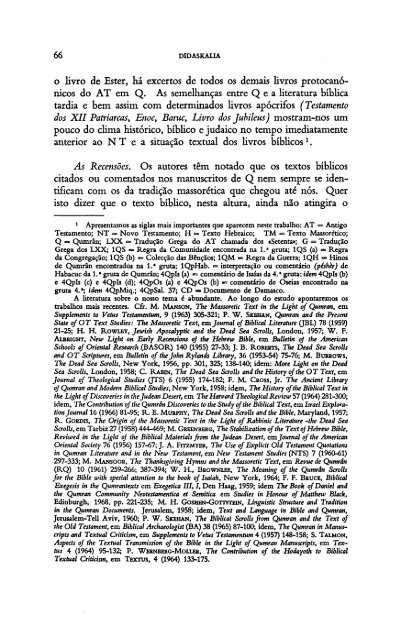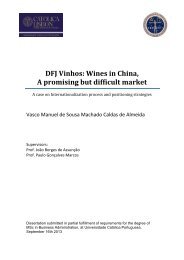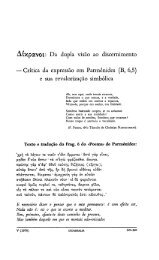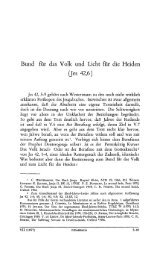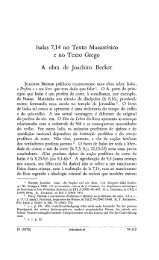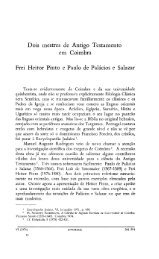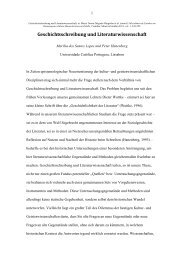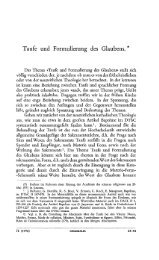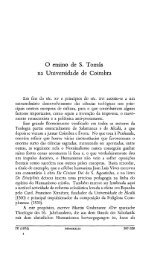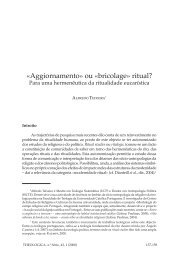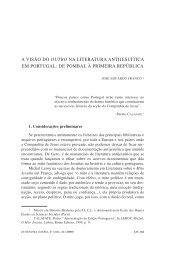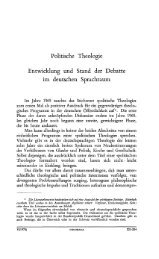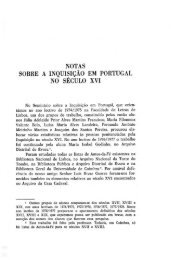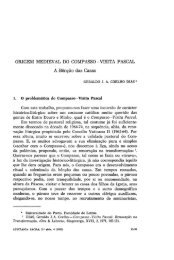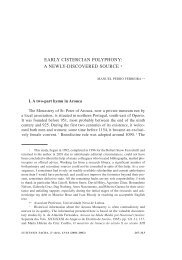QUMRAN Exegese Histórica e Teologia de Salvação
QUMRAN Exegese Histórica e Teologia de Salvação
QUMRAN Exegese Histórica e Teologia de Salvação
You also want an ePaper? Increase the reach of your titles
YUMPU automatically turns print PDFs into web optimized ePapers that Google loves.
66 didaskalia<br />
o livro <strong>de</strong> Ester, há excertos <strong>de</strong> todos os <strong>de</strong>mais livros protocanónicos<br />
do AT em Q. As semelhanças entre Q e a literatura bíblica<br />
tardia e bem assim com <strong>de</strong>terminados livros apócrifos (Testamento<br />
dos XII Patriarcas, Enoc, Baruc, Livro dos Jubileus) mostram-nos um<br />
pouco do clima histórico, bíblico e judaico no tempo imediatamente<br />
anterior ao N T e a situação textual dos livros bíblicos 1 .<br />
As Recensões. Os autores têm notado que os textos bíblicos<br />
citados ou comentados nos manuscritos <strong>de</strong> Q nem sempre se i<strong>de</strong>ntificam<br />
com os da tradição massorética que chegou até nós. Quer<br />
isto dizer que o texto bíblico, nesta altura, ainda não atingira o<br />
1 Apresentamos as siglas mais importantes que aparecem neste trabalho: AT = Antigo<br />
Testamento; NT = Novo Testamento; H •= Texto Hebraico; TM = Texto Massorético;<br />
Q >* Qumrân; LXX = Tradução Grega do AT chamada dos «Setenta»; G = Tradução<br />
Grega dos LXX; 1QS = Regra da Comunida<strong>de</strong> encontrada na 1.* gruta; 1QS (a) =" Regra<br />
da Congregação; 1QS (b) = Colecção das Bênçãos; 1QM = Regra da Guerra; 1QH = Hinos<br />
<strong>de</strong> Qumrân encontrados na 1.* gruta; lQpHab. = interpretação ou comentário (péshb) <strong>de</strong><br />
Habacuc da 1. • gruta <strong>de</strong> Qumrân; 4QpIs (a) comentário <strong>de</strong> Isaias da 4. 1 gruta: i<strong>de</strong>m 4QpIs (b)<br />
e 4QpIs (c) e 4QpIs (d); 4QpOs (a) e 4QpOs (b) -= comentário <strong>de</strong> Oséias encontrado na<br />
gruta 4.*; i<strong>de</strong>m 4QpMiq.; 4QpSal. 37; CD «- Documento <strong>de</strong> Damasco.<br />
A literatura sobre o nosso tema é abundante. Ao longo do estudo apontaremos os<br />
trabalhos mais recentes. Cfr. M. MANSON, The Massoretic Text in the Light of Qumran, em<br />
Supplements to Vetus Testamentum, 9 (1963) 305-321; P. W. SKEHAN, Qumran and the Present<br />
State ofOT Text Studies: The Massoretic Text, em Journal of Biblical Literature (JBL) 78 (1959)<br />
21-25; H. H. ROWLEY, Jewish Apocalyptic and the Dead Sea Scrolls, London, 1957; W. F.<br />
ALBRIGHT, New Light on Early Recensions oj the Hebrew Bible, em Bulletin oj the American<br />
Schools of Oriental Research (BASOR) 140 (1955) 27-33; J. B. ROBERTS, The Dead Sea Scrolls<br />
and OT Scriptures, em Bulletin of the John Rylands Library, 36 (1953-54) 75-76; M. BURROWS,<br />
The Dead Sea Scrolls, New York, 1956, pp. 301, 325; 138-140; i<strong>de</strong>m: More Light on the Dead<br />
Sea Scrolls, London, 1958; C. RABIN, The Dead Sea Scrolls and the History of the OT Text, em<br />
Journal of Theological Studies (JTS) 6 (1955) 174-182; F. M. CROSS, Jr. The Ancient Library<br />
oj Qumran and Mo<strong>de</strong>m Biblical Studies, New York, 1958; i<strong>de</strong>m, The History of the Biblical Text in<br />
the Light of Discoveries in the Ju<strong>de</strong>an Desert, em The Harvard Theological Review 57 (1964) 281-300;<br />
i<strong>de</strong>m, The Contribution of the Qumrân Discoveries to the Study of the Biblical Text, em Israel Exploration<br />
Journal 16 (1966) 81-95; R. E. MURPHY, The Dead Sea Scrolls and the Bible, Maryland, 1957;<br />
R. GORDIS, The Origin of the Massoretic Text in the Light of Rabbinic Literature -the Dead Sea<br />
Scrolls, em Tarbiz 27 (1958) 444-469; M. GREENBERG, The Stabilization of the Text oj Hebrew Bible,<br />
Reviwed in the Light oj the Biblical Materials from the Ju<strong>de</strong>an Desert, em Journal of the American<br />
Oriental Society 76 (1956) 157-67; J. A. FITZMYBR, The Use of Explicit Old Testament Quotations<br />
in Qumran Literature and in the New Testament, em New Testament Studies (NTS) 7 (1960-61)<br />
297-333; M. MANSOOR, The Thanksgiving Hymns and the Massoretic Text, em Revue <strong>de</strong> Qumrân<br />
(RQ) 10 (1961) 259-266; 387-394; W. H„ BROWNLEE, The Meaning of the Qumrân Scrolls<br />
for the Bible with special attention to the book of Isaiah, New York, 1964; F. F. BRUCE, Biblical<br />
Exegesis in the Qumrantexts em Exegetica III, I, Den Haag, 1959; i<strong>de</strong>m The Book of Daniel and<br />
the Qumran Community Neotestamentica et Semítica em Studies in Honour of Matthew Black,<br />
Edinburgh, 1968. pp. 221-235; M. H. GOSHBN-GOTTSTBIN, Linguistic Structure and Tradition<br />
in the Qumran Documents. Jerusalem, 1958; i<strong>de</strong>m, Text and Language in Bible and Qumran,<br />
Jerusalem-Tell Aviv, 1960; P. W. SKEHAN, The Biblical Scrolls from Qumran and the Text of<br />
the Old Testament, em Biblical Archaeologist (BA) 38 (1965) 87-100; i<strong>de</strong>m. The Qumran in Manuscripts<br />
and Textual Criticism, em Supplements to Vetus Testamentum 4 (1957) 148-158; S. TALMON,<br />
Aspects of the Textual Transmission of the Bible in the Light of Qumran Manuscripts, em Textus<br />
4 (1964) 95-132; P. WBRNBBRG-MOLLBR, The Contribution of the Hodayoth to Biblical<br />
Textual Criticism, em TEXTOS, 4 (1964) 133-175.


